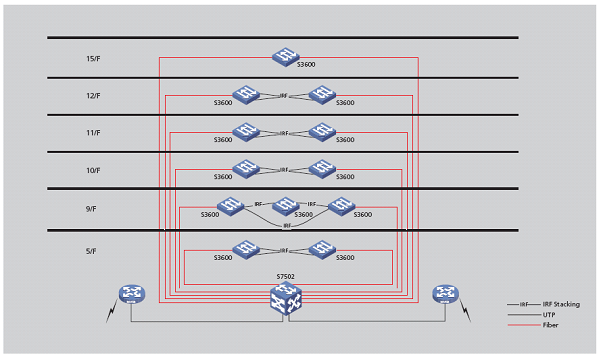The Bank of East Asia Upgrades Network for Business Growth with H3C Solutions
The Client
Incorporated in Hong Kong in 1918, The Bank of East Asia (BEA) is dedicated to providing comprehensive retail and commercial banking services to its customers in Hong Kong, Greater China, and overseas.BEA is the largest independent local bank in Hong Kong, with over 130 branches and SupremeGold Centers throughout the city.BEA also operates more than 60 outlets in Mainland China, one of the largest networks of any foreign bank, as well as branches in the US, Canada, the UK, the British Virgin Islands, and Southeast Asia. In total, BEA has more than 240 outlets and employs over 10,000 people around the world.
The Requirement
Following its formal merger with the United Chinese Bank (UCB) in 2001, BEA took over the management of UCB’s 13-storey headquarters in Central, Hong Kong. The UCB Building’s office network, which consisted mainly of Layer 2 switches and WAN routers, was limited in scalability, would have been costly to expand, and a number of components were nearing the end-of-life (EOL). To offer more robust services to its staff and support new network-based applications as it expanded its business, BEA needed to upgrade the UCB Building network. Turning to H3C, the Bank was able to deploy a more flexible and scalable solution.
The Solution
The type of network infrastructure that BEA had been using in its UCB Building offices was purely a Layer 2 network. The edge switches located on each floor were cascaded. Whenever the Bank wanted to expand its network capabilities to new floors, it required additional edge switches and the insertion of an expensive new interface card into the existing WAN routers to handle the Layer 3 routing to any new floors. To solve this, H3C deployed a Multi-Service Core Routing switch, the H3C S7502 (with full wire-speed L2 and L3) on the fifth floor, which could handle the Layer 3 routing to all floors in place of the existing WAN routers. The H3C S7502 core switch features a switching capacity of up to 192Gbps and a forwarding capacity of 144Mbps. The H3C S7502 provides outstanding network performance, higher port density, and greater flexibility, which makes connection to the core layer of enterprise networks ideal.
To replace the existing non-stackable edge switches, H3C installed its S3600-26TP-SI switches on each floor, which were stacked by built-in 1000Base-T SFPs, using Intelligent Resilient Framework (IRF) technology. The stack connects back to the core via dual Gigabit Ethernet fibers, resulting in a highly scalable, reliable, and manageable network. The H3C S3600 series switches are Fast Ethernet L3 Intelligent and Resilient switches that feature H3C’s innovative IRF resilient network technology. This advanced technology allows enterprise customers to design and implement Fast Ethernet core and aggregation networks that are highly adaptable. This lets the edge switches behave as a single logical switching entity called a Distributed Fabric. In addition, the edge switch ports for user workstation connections are configured as edge ports, which allow traffic to be forwarded without the need to wait. The S3600 series switches support a switching capacity of up to 12.8Gbps and a forwarding capacity of up to 9.53Mpps.
To prevent malicious attacks on the switch via the edge ports, the H3C-powered network was designed with Bridge Protocol Data Unit (BPDU) protection. Broadcast suppression was also configured on the edge ports to control broadcast storm attacks, which prohibits the transfer of broadcast traffic when it reaches the rate of 500pps. Further improving network security, the new H3C equipment allows better management of IP addresses using simple remote management and administration tools.

Why H3C?
A new customer of H3C, BEA was impressed by the network provider’s strong technical support and its reputation for providing quality, value-added solutions. H3C was deeply involved in the project from the initial stage, assisting BEA in terms of network design and consultancy. During installation, H3C arranged a virtual technical team with its partner to support BEA’s IT team to ensure the deployment was smooth, on-time, and within budget. Another contributing factor in H3C’s favor was its outstanding price-to-performance ratio that gives customers like BEA more benefits for their IT dollar. H3C’s ongoing support after the installation has reinforced BEA’s choice of network provider.
The Benefits
As BEA continues to expand its business, it needs cost-effective, full-service network infrastructure to support ongoing growth. Following the installation of the H3C equipment, BEA’s network now possesses the necessary scalability, as well as improved reliability and performance capability. Additionally, BEA no longer needs to worry about its network products reaching EOL with the new equipment from H3C.
Leveraging the stacking capacity of H3C’s IRF technology, BEA will be able to cost-effectively expand its network as its needs require. Scalability is further improved by the network’s ability to off-load the two existing WAN routers without worrying about the number of interfaces left. BEA can also take advantage of the new network’s ability to flexibly create VLANs for each floor and inter-VLAN routing that is done directly through the switches without the hassle and expense of adding router interface cards. Using the Multiple Spanning Tree Protocol (MSTP) to provide multiple redundant paths for packet forwarding, BEA will benefit from the implementation of VLAN-based load balancing, which is handled by the core switch.
“To support our expansion plans, BEA needs a capable, resilient, and scalable network. H3C offered a solution that met our requirements and allows us to enjoy the advantages of a more cost effective, reliable, and high performance network. We are also seeing IT cost savings from the improved and simplified management capabilities of the H3C-powered network.” - Jonathan Siu, Technical Support Manager, The Bank of East Asia


